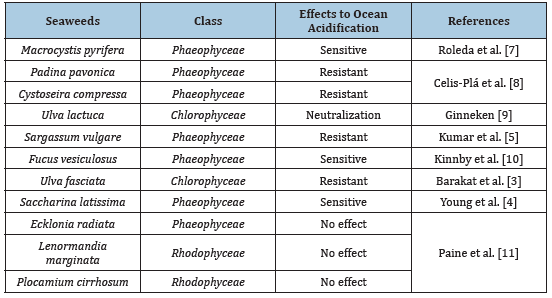- Submissions

Full Text
Examines in Marine Biology & Oceanography
Ocean Acidification: Positive and Negative Impacts on Seaweeds
Gour Gopal Satpati*
Department of Botany, Bangabasi Evening College, Kolkata, West Bengal, India
*Corresponding author: Gour Gopal Satpati, Department of Botany, Bangabasi Evening College, 19 Rajkumar Chakraborty Sarani, Kolkata- 700009, West Bengal, India
Submission: August 04, 2023;Published: August 09, 2023

ISSN 2578-031X Volume6 Issue2
Opinion
Due to industrial revolution and anthropogenic activities carbon-di-oxide (CO2) in the atmosphere has increased day by day. Deforestation, burning of fossil fuels, forest fires resulting in the enhancement of CO2 in the ocean ecosystem. About 30% of the atmospheric CO2 is absorbed by the ocean surface water which results in carbonic acids. The carbonic acids formed cause harmful effects to marine aquatic lives including sea animals and seaweeds. A series of chemical reactions results in the formation of carbonic acids and bicarbonates which has a bad impact on the living creatures. Marine organisms, especially hard shell containing species like corals and oysters become more effective as their skeleton is formed by the dissolved carbonate and calcium. On the other hand, clownfish have decreased in the additional acidic waters than normal marine water. Around 14-17 billion years ago, at the age of the middle Miocene, the pH of the ocean was less than 8 which resembles the present day environment (https://www.noaa.gov/education/resource-collections/ocean-coasts/ocean-acidification).
Seaweed are the marine photosynthetic macrophytes that can absorb CO2 for basic growth and synthesis of metabolic compounds [1,2]. Fluctuations of CO2 on the surface water causes noteworthy influences in the metabolism of seaweeds in early stages of growth and development [3]. Study revealed that the brown (Phaeophyceae) and red (Rhodophyceae) seaweeds are dominant in marine ecosystems and play an important role in the food web of the ocean. Seaweeds sometimes become sensitive to Ocean Acidification (OA). On the other hand, OA promotes the growth and other physiological activities of seaweeds. The Atlantic Kelp, Saccharina latissima protected blue mussels, juvenile hard clams and eastern oysters from OA [4]. Biological activities like polysaccharides, fucoidan and alginate were highly synthesized in acidic sites than non-acidic sites [5]. Fluctuating pH in the culture of Ecklonia radiata resulted in sufficient growth and photosynthetic activity at juvenile stage [6]. The positive and negative impacts of seaweeds on OA has been highlighted in (Table 1).
Table 1:Effects of seaweeds to ocean acidification.

Modern technologies have also been suggested to control OA in an eco-friendly way. Integrated algal bioreactors with H+ absorbance capacity can control OA and are suggested to protect coral reefs and seaweeds [9]. Three dimensional kelp forests are very influential to OA and help to increase the growth of bivalves of North Atlantic origin [4]. It has also been suggested that the co-culture of kelp and marine bivalves can reduce OA in the present day and near future.
References
- Satpati GG, Barman N, Pal R (2012) Morphotaxonomic account of some common seaweeds from Indian Sundarbans mangrove forest and inner island area. J. Algal Biomass Utln 3(4): 45-51.
- Satpati GG, Mal N, Pal R (2021) Seaweed-based interventions for diabetic complications: An analytical discourse. Syst Biosci Eng 1(1): 53-66.
- Barakat KM, El-Sayed HS, Khairy HM, El-Sheikh MA, Al-Rashed SA, et al. (2021) Effects of ocean acidification on the growth and biochemical composition of a green alga (Ulva fasciata) and its associated microbiota. Saudi J Biol Sci 28(9): 5106-5114.
- Young CS, Sylvers LH, Tomasetti SJ, Lundstrom A, Schenone C, et al. (2022) Kelp (Saccharina latissima) mitigates coastal ocean acidification and increases the growth of North Atlantic bivalves in lab experiments and on an oyster farm. Front Mar Sci 9: 881254.
- Kumar A, Buia MC, Palumbo A, Mohany M, Wadaan MAM, et al. (2020) Ocean acidification affects biological activities of seaweeds: A case study of Sargassum vulgare from Ischia volcanic CO2 Environ Pollut 259: 113765.
- Britton D, Cornwall C, Revill A, Hurd CL, Johnson CR (2016) Ocean acidification reverses the positive effects of seawater pH fluctuations on growth and photosynthesis of the habitat-forming kelp, Ecklonia radiata. Sci Rep 6: 26036.
- Roleda MY, Morris JN, McGraw CM, Hurd CL (2011) Ocean acidification and seaweed reproduction: Increased CO2 ameliorates the negative effect of lowered pH on meiospore germination in the giant kelp Macrocystis pyrifera (Laminariales, Phaeophyceae). Glob Chang Biol 18(3): 854-864.
- Celis-Plá PSM, Hall-Spencer JM, Horta PA, Milazzo M, Korbee N, et al. (2015) Macroalgal responses to ocean acidification depend on nutrient and light levels. Front Mar Sci 2: 26.
- Ginneken VV (2019) The application of the seaweeds in neutralizing the “Ocean Acidification” as a long-term multifaceted challenge. J Geosci Environ Prot 7(12): 126-138.
- Kinnby A, White JCB, Toth GB, Pavia H (2021) Ocean acidification decreases grazing pressure but alters morphological structure in a dominant coastal seaweed. PLoS ONE 16(1): 1-14.
- Paine ER, Britton D, Schmid M, Brewer EA, Diaz-Pulido G, et al. (2023) No effect of ocean acidification on growth, photosynthesis, or dissolved organic carbon release by three temperate seaweeds with different dissolved inorganic carbon uptake strategies. ICES J Mar Sci 80(2): 272-281.
© 2023 Gour Gopal Satpati. This is an open access article distributed under the terms of the Creative Commons Attribution License , which permits unrestricted use, distribution, and build upon your work non-commercially.
 a Creative Commons Attribution 4.0 International License. Based on a work at www.crimsonpublishers.com.
Best viewed in
a Creative Commons Attribution 4.0 International License. Based on a work at www.crimsonpublishers.com.
Best viewed in 







.jpg)






























 Editorial Board Registrations
Editorial Board Registrations Submit your Article
Submit your Article Refer a Friend
Refer a Friend Advertise With Us
Advertise With Us
.jpg)






.jpg)














.bmp)
.jpg)
.png)
.jpg)










.jpg)






.png)

.png)



.png)






